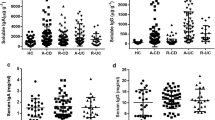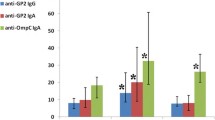Abstract
Lipid A is a component common to endotoxins of gram-negative bacteria. It has been suggested that the gut wall of patients with inflammatory bowel disease is more permeable to luminal bacterial macromolecules which may stimulate the gut-associated lymphoid tissue. We therefore investigated 40 patients with Crohn's disease (CD) and 23 patients with ulcerative colitis (UC) with respect to their lipid A antibody titers and presence of endotoxins (Limulus test). Both tests were performed simultaneously using peripheral venous blood. Systemic endotoxin was demonstrated in only two of the patients. The lipid A antibody titers in the CD patients were significantly higher than either in patients with UC or in 42 healthy controls. Lipid A titiers of patients with UC did not differ from those of controls. Titers of lipid A were significantly higher in patients with active Crohn's disease than in patients with inactive disease. It is concluded that systemic endotoxemia occurs rarely in patients with inflammatory bowel disease; however, despite this virtual absence of endotoxins in their peripheral blood, patients with CD show an increase in antibody formation against lipid A. This is suggestive of an altered immunologic reactivity against endotoxins in patients with CD and may be relevant to the pathogenesis of this disease.
Similar content being viewed by others
References
Drasar BS, Shiner M: Studies on the intestinal flora. II. Bacterial flora of the small intestine in patients with gastrointestinal disorders. Gut 10:812–819, 1969
Gorbach SL, Tabaqchali S: Bacteria, bile and the small bowel. Gut 10:963–972, 1969
Gorbach SL: Intestinal microflora. Gastroenterology 60:1110–1129, 1971
Vince A, Dyer NH, O'Grady FW, Dawson AM: Bacteriological studies in Crohn's disease. J Med Microbiol 5:219–229, 1972
Wensinck F: Faecal flora of Crohn's patients. Serological differentiation between Crohn's disease and ulcerative colitis.In The Management of Crohn's Disease. JT Weterman, AS Pena, CL Booth (eds). Amsterdam, Excerpta Medica, 1976, pp 103–107
Sachar DB, Auslander MO, Walfish JS: Aetiological theories of inflammatory bowel disease. Clin Gastroenterol 9:231–257, 1980
Orr MM: Experimental intestinal granulomas. Proc R Soc Med 68:14, 1975
Parent K, Mitchell PD: Bacterial variants: Etiologic agents in Crohn's disease? Gastroenterology 71:365–368, 1976
Parent K, Mitchell PD: Cell wall defective variants ofPseudomonas-like (group Va) bacteria in Crohn's disease. Gastroenterology 75:368–372, 1978
Shafii A, Sopher S, Lev M, Das KM: An antibody against revertant forms of cell-wall deficient bacterial variant in sera from patients with Crohn's disease. Lancet 1:332–334, 1981
Graham DY, Estes MK: Cell wall defective bacteria and Crohn's disease. Gastroenterology 76:1142, 1979
Belsheim MR, Darwish R, Watson WC, Sullivan SN: Bacterial L forms in inflammatory bowel disease. Gastroenterology 5:1139, 1980
Schussler P, Kruis W, Marget W: Lipoid-A-Antikorper-titer und O-Antikorpertiter bei Enterocolitis Crohn, Colitis ulcerosa und akuter Enteritis. Med Klin 71:1898–1902, 1976
Tabaqchali S, O'Doughue DP, Bettelheim KA: Escherichia coli antibodies in patients with inflammatory bowel disease. Gut 19:108–113, 1978
Mathews N, Mayberry JF, Rhodes J, Neale L, Munro J, Wensinck F, Lawson GHK, Rowland AC, Berkhoff GA, Barthold SW: Agglutinins to bacteria in Crohn's disease. Gut 21:376–380, 1980
Peach S, Lick MR, Katz D, Todd JP, Tabaqchali S: Mucosal-associated bacterial flora of the intestine in patients with Crohn's disease and in a control group. Gut 19:1034–1042, 1978
Shorter RG, Huizenga KA, Spencer RJ: A working hypothesis for the etiology and pathogenesis of nonspecific inflammatory bowel disease. Dig Dis Sci 17:1024–1032, 1972
Bladen HA, Gewurz H, Mergenhagen JE: Interactions of the complement system with the surface and endotoxic lipopolysaccharide ofVeillonella alcalescens. J Exp Med 125:767–786, 1967
Neter E: Endotoxins and the immune response. Curr Top Microbiol Immunol 47:82–124, 1969
Westphal O: Bacterial endotoxins. Int Arch Allergy 49:1–43, 1975
Galanos C, Rietschel ET, Luderitz O, Westphal O, Kim YB, Watson DW: Biological activities of lipid A complexed to bovine serum albumin. Eur J Biochem 31:230–233, 1972
Elin RJ, Wolff SM: Biology of endotoxin. Am Rev Med 27: 127–141, 1976
Kruis W, Eisenburg J: Die Differentialdiagnose Morbus Crohn-Colitis Ulcerosa. Dtsch Med Wochenschr 106:1003–1006, 1981
Best W, Becktel J, Singleton J, Kern F: Development of Crohn's disease activity index. Gastroenterology 70:439–444, 1976
Truelove SC, Witts LF: Cortisone in ulcerative colitis. Br Med J 2:1041–1048, 1955
Galanos C, Luderitz O, Westphal O: Preparation and properties of antisera against the lipid A component of bacterial lipopolysaccharides. Eur J Biochem 24:116–121, 1971
Levin J, Bang FB: Clottable protein in limulus: Its localization and kinetics of its coagulation by endotoxin. Thrombos Diathes Haemorrh 19:186–197, 1968
Hollander M, Wolfe DA: Nonparametric Statistical Methods. J. Wiley & Sons, New York, 1973
Jacob AJ, Goldberg PHK, Bloom N, Degenshein GA, Kozinn PHJ: Endotoxin and bacteria in portal blood. Gastroenterology 72:1268–1270, 1977
Palmer KR, Duerden BJ, Holdsworth CD: Bacteriological and endotoxin studies in cases of ulcerative colitis submitted to surgery. Gut 21:851–854, 1980
Bradfield JWB: Control of spillover. Lancet 2:883–886, 1974
Bjorneboe M, Prytz H, Orskov F: Antibodies to intestinal microbes in serum of patients with cirrhosis of the liver. Lancet 1:58–60, 1972
Grun M, Liehr H, Grun W, Rasenack U, Brunswig D: Influence of liver-RES on toxic liver damage due to galactosamine. Acta Hepato-Gastroenterol 21:5–10, 1974
Liehr H, Grun M: Endotoxine und RES-Funktion in der Pathogenese von Lebererkrankungen. Internist 17:122–128, 1976
Liehr H: The limulus assay for endotoxemia as applied in gastroenterology.In Biomedical Application of the Horseshoe Crab (Limulidae). E Cohen (ed). Progr Clin Biol Res 29:309–320, 1978
Levin J, Tomasulo PA, Oser RS: Detection of endotoxin in human blood and demonstration of an inhibitor. J Lab Clin Med 75:903–911, 1970
Cooper JF, Levin J, Wagner HN: Quantitative comparison ofin-vitro andin-vivo methods for the detection of endotoxin. J Lab Clin Med 78:138–148, 1971
Nolan JP, Hare DK, McDevitt JJ, Ali MV:In vitro studies of intestinal endotoxin absorption. I. Kinetics of absorption in the isolated everted gut sac. Gastroenterology 72:434–439, 1977
Stumacher KJ, Kovnatt MJ, McCabe WR: Limitations of the usefulness of the limulus assay for endotoxin. N Engl J Med 288:1261–1264, 1973
Elin RJ, Wolff SM: Nonspecificity of the limbus amebocyte lysate test: Positive reactions with polynucleotides and proteins. J Infect Dis 128:349–352, 1973
Schussler P, Kruis W, Marget W: Lipoid-A-Antikorper-titer bei Morbus Crohn. Klin Wochenschr 54:1055–1056, 1976
Vorsmeyer S, Strickland RG, Wilson ID, Williams RC: Serum lymphocytotoxic and lymphocytophilic antibody activity in inflammatory bowel disease. Gastroenterology 67:578–583, 1974
Korsmeyer SJ, Williams RC, Wilson ID, Strickland RG: Lymphocytotoxic and RNA antibodies in inflammatory bowel disease: A comparative study in patients and their families. Ann NY Acad Sci 278:574–584, 1976
Strickland RG, Miller WC, Volpicelli NA, Gaeke EF, Wilson ID, Kirsner JB, Williams RC: Lymphocytotoxic antibodies in patients with inflammatory bowel disease and their spouses—evidence for a transmissable agent. Clin Exp Immunol 30:188–192, 1977
Dettoratius RJ, Strickland DG, Miller WC, Volpicelli NA, Gaeue RF, Kirsner JB, Williams RC: Antibodies to synthetic polyribonucleotides in spouses of patients with inflammatory bowel disease. Lancet 1:1116–1119, 1978
Lagercrantz R, Hammarstrom S, Perlmann P, Gustaffsson BE: Immunological studies in ulcerative colitis. III. Incidence of antibodies to colonantigen in ulcerative colitis and other gastrointestinal diseases. Clin Exp Immunol 1:263–276, 1968
Thayer WR, Brown M, Huyett Sangree M, Katz J, Hersh T:Escherichia coli 0∶14 and colon hemagglutinating antibodies in inflammatory bowel disease. Gastroenterology 57:311–318, 1969
Watson DW, Bartnik W, Shorter RG: Lymphocyte function and chronic inflammatory bowel disease.In Inflammatory Bowel Disease. JB Kirsner, RG Shorter (eds). Philadelphia, Lea and Febiger, 1980, pp 121–137
Gorbach SL: Intestinal microflora in inflammatory bowel disease—implications for etiology and therapy.In Inflammatory Bowel Disease. JB Kirsner, RG Shorter (eds). Philadelphia, Lea and Febiger, 1980, pp 55–70
Kirsner JB, Shorter RG: Recent developments in nonspecific inflammatory bowel disease. N Engl J Med 306:837–848, 1982
Crabbé PA, Heremans JF: The distribution of immunoglobulin containing cells along the human gastrointestinal tract. Gastroenterology 51:305, 1966
Walker WA: Host defense mechanisms in the gastrointestinal tract. Pediatrics 57:901–916, 1976
Spector WG, Heesom N: The production of granulomata by antigen-antibody complexes. J Pathol 98:31–39, 1969
Author information
Authors and Affiliations
Rights and permissions
About this article
Cite this article
Kruis, W., Schussler, P., Weinzierl, M. et al. Circulating lipid A antibodies despite absence of systemic endotoxemia in patients with Crohn's disease. Digest Dis Sci 29, 502–507 (1984). https://doi.org/10.1007/BF01296269
Received:
Revised:
Accepted:
Issue Date:
DOI: https://doi.org/10.1007/BF01296269




